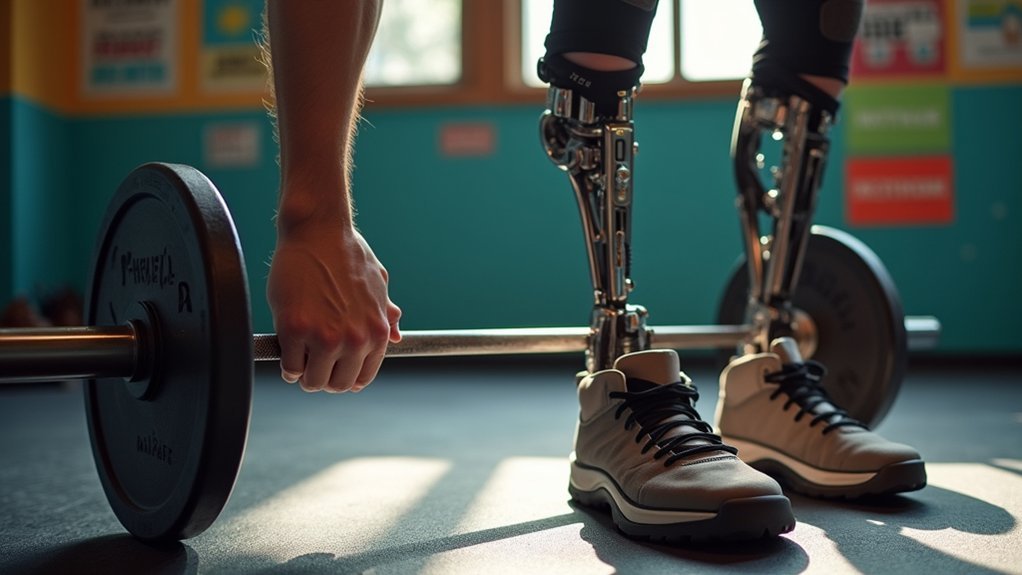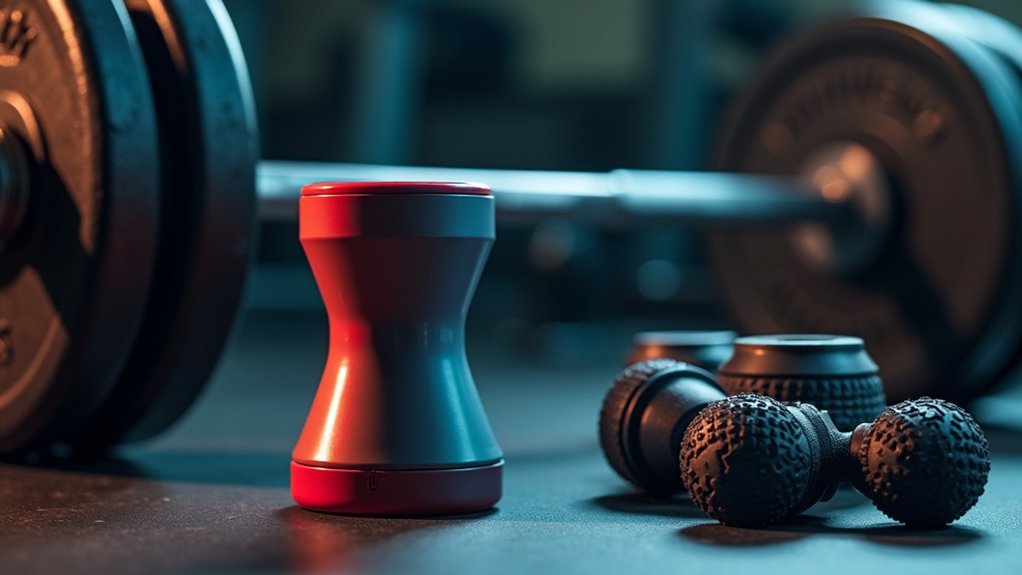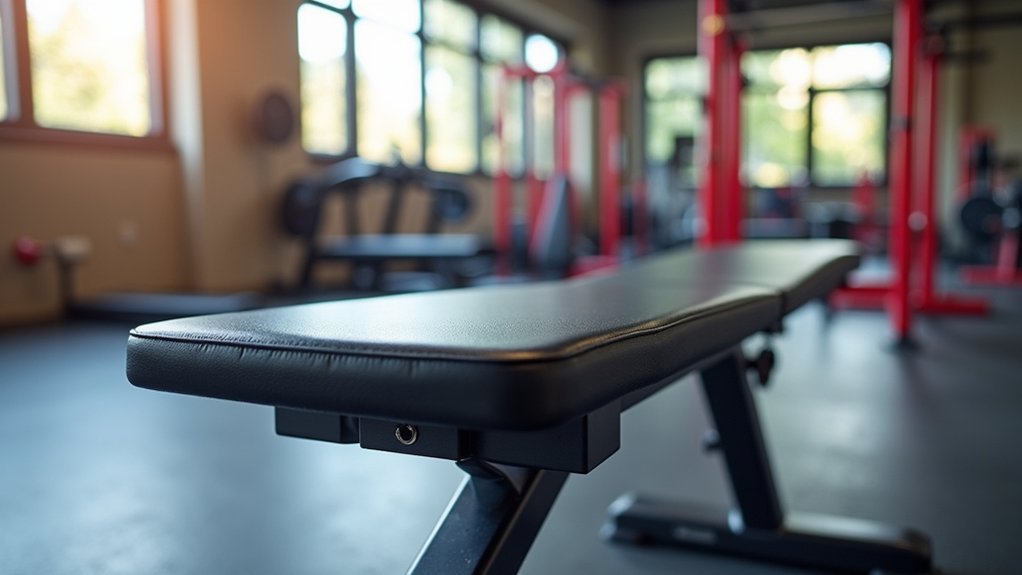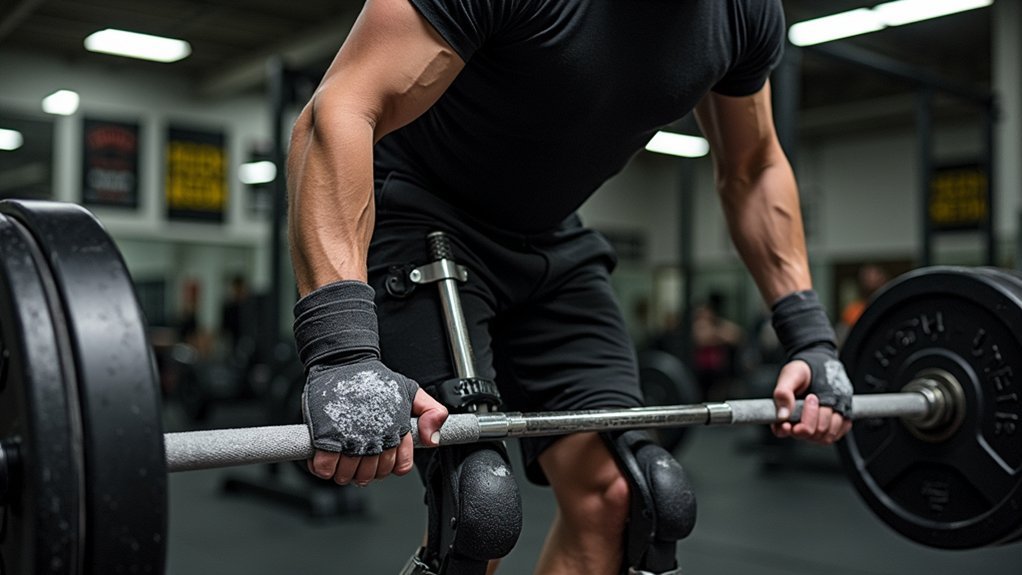Adaptive equipment makes weightlifting accessible for amputees at all fitness levels. You’ll benefit from specialized terminal devices that support 40+ pounds, custom sockets for stability, and grip solutions like hooks and harnesses that distribute weight evenly. Adjustable benches with anti-slip surfaces prevent sliding, while medicine balls and resistance bands offer grip-free strength training options. Balance tools help prevent asymmetries during unilateral movements. The right combination of tools transforms limitations into new strength-building possibilities.
What Equipment Helps Amputees Weightlift Effectively?

While traditional weightlifting equipment presents significant challenges for amputees, specialized adaptive tools have revolutionized their workout possibilities.
Heavy-duty partial hand prostheses from companies like Point Design and Naked Prosthetics enable secure gripping of weights during lifting exercises.
Modern partial hand prostheses transform weight training for amputees, offering secure grip solutions for traditional lifting exercises.
Weight-lifting hooks alleviate strain on your hands and wrists, allowing you to continue training even after grip fatigue sets in.
For those preferring home workouts, resistance bands offer versatile strengthening options that adapt to your specific needs.
The Aldridge Arm Harness represents essential adaptive equipment that distributes weight evenly across your torso, making traditionally two-handed lifts possible from a seated position.
Additionally, medicine balls provide an excellent alternative to conventional weights, as they’re easier to grip while still effectively building core strength and stability.
Prosthetic Terminal Devices Designed for Weightlifting
Prosthetic terminal devices have transformed weightlifting possibilities for amputees, offering specialized solutions beyond general adaptive equipment.
When you’re serious about strength training, consider heavy-duty options from manufacturers like Point Design and Naked Prosthetics.
The Multi D terminal device supports lifting 40+ pounds, making it ideal for your strength training regimen. These innovations in prosthetic technology feature durable materials and adjustable BOA systems that guarantee secure fit during intense workouts.
If standard devices don’t meet your needs, custom activity-specific prosthetics can be tailored to your unique requirements.
User feedback has driven significant advancements in terminal device design, addressing specific challenges you’ll face at the gym.
With these purpose-built solutions, you’ll experience enhanced grip, stability, and confidence while pursuing your weightlifting goals.
Custom Activity-Specific Sockets and Attachments

Because successful weightlifting requires equipment that can withstand significant force, custom activity-specific sockets represent a critical advancement for amputee athletes.
These specialized sockets accommodate your unique limb differences while providing the stability you need for lifting heavy weights.
When considering custom solutions for your weightlifting regimen, focus on:
- Materials and fit – Durable components with adjustable systems like BOA provide the secure attachment needed for confidence during lifts.
- Terminal device selection – Options like JAWS or Multi-D pivot attachments allow you to grip weights effectively based on your specific needs.
- Professional guidance – Working with a certified prosthetist guarantees your custom socket and terminal device combination matches your weightlifting goals.
Your feedback on these specialized devices helps drive innovation in adaptive weightlifting equipment, benefiting the entire community.
Adaptive Grip Solutions for Partial Hand Differences
For individuals with partial hand differences, adaptive grip solutions offer specialized weightlifting capabilities that complement the socket-based systems used by other amputee athletes.
Products from Point Design and Naked Prosthetics provide terminal devices specifically engineered for weightlifting activities, allowing you to lift heavier loads safely.
The Multi D device stands out with its impressive 40+ pound capacity, demonstrating how far adaptive grip technology has evolved.
You’ll find both passive and body-powered options available to match your specific needs and preferences.
Don’t hesitate to explore custom-built activity-specific devices tailored to your unique lifting requirements.
For additional support, consider supplementing your prosthesis with lifting hooks and gripping gloves to reduce hand and wrist strain, preventing grip fatigue during intense workouts.
Specialized Weight Benches and Platforms for Stability

When traditional gym equipment falls short of meeting your specific needs as an amputee athlete, specialized weight benches and platforms can transform your lifting experience.
These adaptive solutions prioritize stability while accommodating your unique body mechanics.
Specialized weight benches feature adjustable heights and widths, creating a custom fit that supports proper form during your lifts. Many include built-in support systems like harnesses or straps to help you maintain ideal positioning.
Look for these key features:
- Anti-slip surfaces that prevent dangerous sliding during exercise
- Lateral stability arms that provide balance assistance during unilateral movements
- Customizable dimensions that accommodate your specific limb differences
These thoughtful design elements guarantee you’ll experience enhanced stability, reduced injury risk, and greater confidence when tackling challenging weightlifting routines.
Resistance Bands and Pulley Systems for Graduated Training
Resistance bands offer you a progressive training solution that can be adjusted from light to challenging resistance levels without the intimidation of traditional weights.
You’ll find systems like the Bodylastics Stackable Tube set particularly valuable as they allow for incremental strength building while accommodating various amputation types.
Door-mounted pulley systems further expand your exercise options by creating accessible workout stations where you can perform rows and flys even without conventional grip capabilities.
Versatile Progressive Resistance
As athletes progress in their weightlifting journey, adaptable equipment becomes essential for continued growth. Bodylastics Stackable Tube Resistance Bands offer versatile resistance training options that evolve with your strength gains.
You’ll find these bands particularly valuable because they transform any doorway into a complete exercise station—perfect for amputees seeking consistent training regardless of location.
The adaptive design includes:
- Multiple resistance grades that stack together, allowing you to precisely increase difficulty as you develop.
- Two handles and padded ankle straps that accommodate various limb differences for effective upper and lower body workouts.
- Optional pulley system integration that creates dynamic movement patterns, enhancing coordination while maintaining safety.
You’ll appreciate how these portable solutions provide progressive challenges without requiring bulky equipment or gym memberships.
Adapting Without Grip
For amputees who lack traditional grip capability, resistance bands coupled with pulley systems offer exceptional alternatives to conventional weightlifting equipment.
The Bodylastics Stackable Tube set allows you to customize resistance levels to match your specific strength needs and abilities, making it ideal adaptive fitness equipment for your home workouts.
By attaching resistance bands to a doorway, you’ll instantly create a versatile exercise station without specialized equipment.
The pulley systems effectively eliminate grip requirements while allowing you to perform movements that mirror traditional weightlifting exercises like rows and flys.
This combination targets important muscle groups while promoting functional movement patterns that benefit daily activities.
You’ll build strength progressively and safely, as these systems distribute resistance evenly across your body rather than concentrating it in your hands or prosthetics.
Medicine Balls and Sandbags for Balanced Resistance
Medicine balls and sandbags offer you exceptional core stability training options that adapt to various amputation types while minimizing balance challenges.
You’ll find grip-free workout alternatives with sandbags that can be pressed, carried, or hugged without requiring prosthetic attachments.
The adaptable weight distribution of these tools lets you modify resistance by shifting the medicine ball’s position or adjusting how the sandbag’s contents settle during movement.
Core Stability Training
The foundation of successful weightlifting for amputees often lies in developing exceptional core stability.
Medicine balls and sandbags offer unique advantages for building core strength that traditional weights can’t match. These adaptive tools provide unstable resistance that forces your trunk muscles to work harder during exercises.
When incorporating these tools into your routine:
- Hold medicine balls (4-30 pounds) between your arms or legs during exercises like Russian twists or wall balls to improve proprioception.
- Use sandbags for dynamic movements that challenge your balance while strengthening multiple muscle groups simultaneously.
- Progress gradually through different weights and movements as your coordination and stability improve.
This functional approach to core training enhances your ability to maintain proper form during weightlifting, reducing injury risk and improving overall performance.
Grip-Free Workout Options
While traditional weightlifting equipment often demands secure gripping ability, adaptive tools like medicine balls and sandbags offer excellent alternatives for amputees seeking effective resistance training.
Unlike trying to grip a barbell, these versatile implements can be cradled between limbs or pressed against your body, creating effective resistance without requiring traditional hand positions.
Medicine balls range from 4 to 30 pounds with pliable shells that enhance comfort and minimize slipping, making them ideal for various strength levels.
Their design provides superior control compared to dumbbells.
Similarly, sandbags adapt to your body’s contours while building resistance and stability simultaneously.
Adaptable Weight Distribution
For amputees maneuvering strength training, balanced weight distribution represents a critical factor in preventing overcompensation and potential injury. Medicine balls and sandbags offer superior adaptable weight distribution compared to traditional exercise equipment like dumbbells.
These versatile tools enhance your fitness routine in several ways:
- Medicine balls (4-30 pounds) feature pliable shells that you can grip, hug, or balance against your body, allowing for gradual strength progression without overloading residual limbs.
- Sandbags provide shifting resistance that can be positioned between limbs, addressing asymmetry concerns while improving core strength and balance.
- Both tools facilitate functional movements that accommodate your specific limb differences, enabling you to perform exercises that might otherwise be challenging due to grip limitations.
Weight-Lifting Hooks and Grip Assistance Tools
Specialized grip equipment opens up new possibilities for amputee weightlifters who struggle with traditional holds. Weight-lifting hooks like DMoose feature nonslip coated steel with nylon Velcro straps, allowing you to lift heavier weights without straining your hands or wrists. These tools are particularly valuable for one-handed exercises like kettlebell swings.
| Tool Type | Benefits |
|---|---|
| Steel Hooks | Reduces hand strain |
| Nylon Straps | Secure attachment |
| Grip Assists | Enhances control |
| Nonslip Coating | Prevents slipping |
| Active Hands | Supports past fatigue |
You’ll find these devices help you exercise beyond grip fatigue, improving your overall lifting performance. They’re designed to reduce injury risk, ensuring safer workouts regardless of your limb differences. With proper grip assistance, you can focus on building strength rather than struggling with holds.
Harnesses and Straps for Two-Handed Exercises
Harnesses and straps like the Equip Products Aldridge model distribute weight evenly across your torso, enabling you to perform two-handed exercises despite upper-body disabilities.
You’ll find the cushioned nylon design creates stability while allowing for a full range of motion during deadlifts and farmer’s carries.
The industrial-strength D-rings, rated for up to 10,000 pounds, guarantee your lifts remain secure regardless of the weight you’re working with.
Torso Weight Distribution
When traditional two-handed exercises seem impossible for amputee athletes, specialized harnesses and straps transform these limitations into opportunities. Proper torso weight distribution is essential for stability, safety, and effective strength building.
The Equip Products Aldridge Arm Harness & Strap, with its 10,000-pound rated D-ring, offers reliable support for athletes with limb differences.
For peak torso weight distribution, you’ll want to:
- Confirm the harness fits snugly across your upper body without restricting breathing
- Make specific adjustments if you have breasts to prevent discomfort during lifts
- Test the even weight distribution before attempting heavy lifts to verify balance
These adaptations distribute force across your entire torso, enabling you to perform deadlifts and farmer’s carries with confidence while engaging muscles symmetrically.
Secure Lifting Mechanics
To achieve secure lifting mechanics as an amputee, you’ll need properly fitted harnesses that maintain natural body alignment during complex exercises. Products like the Equip Products Aldridge Arm Harness & Strap enable you to perform traditionally two-handed movements such as deadlifts and farmer’s carries with confidence.
These specialized harnesses distribute weight evenly across your torso through cushioned nylon material, creating stability during exercise. The D-rings can support up to 10,000 pounds, ensuring safety even during heavy lifts.
When properly adjusted, these devices help you maintain correct form despite upper body limitations. For peak performance, make necessary adjustments to accommodate your specific body shape.
This is particularly important for female lifters who need proper breast accommodation while maintaining secure lifting mechanics throughout their workout routine.
Customized Dumbbells and Kettlebells for Unilateral Training
Three key innovations in customized weightlifting equipment have revolutionized training options for amputee athletes. You’ll find these specialized tools offer superior control while maintaining effective resistance training.
Customized dumbbells with ergonomic grips address asymmetry challenges, allowing you to perform exercises with proper form despite limb differences. These adaptations distribute weight evenly, reducing strain and improving stability.
- Adjustable handles that can be fitted to existing weights, enabling traditional exercises without purchasing entirely new equipment.
- Bespoke attachments with secure cuffs that accommodate various amputation levels while providing progressive resistance options.
- Ergonomically designed grips that minimize compensation patterns and maintain balanced muscle development.
These specialized tools empower you to train unilaterally, building strength systematically while adapting to your unique needs.
Adjustable Cuff Weights for Residual Limb Strengthening
Adjustable cuff weights offer unparalleled benefits for residual limb strengthening, complementing the unilateral training equipment discussed above.
You’ll appreciate how these weights can be perfectly tailored to fit your residual limb, creating a customized resistance training experience that builds both strength and endurance.
Available in various increments, adjustable cuff weights allow you to progressively increase resistance as your strength develops.
Progressive strength building made simple with adjustable cuff weights in various resistance levels.
The secure Velcro or adjustable straps guarantee a snug fit during exercises, preventing dangerous slippage while you work out.
What makes these weights especially valuable is their versatility—they integrate seamlessly with other adaptive equipment to target specific muscle groups.
Balance and Stability Equipment for Asymmetry Prevention
When working with prosthetics during weightlifting, maintaining proper balance becomes critical for preventing muscular asymmetry and potential injury.
You’ll need specialized equipment to enhance stability and guarantee proper form throughout your workout routine.
- Adjustable benches with non-slip surfaces provide secure support, helping you stabilize your body while lifting and preventing uneven strain that could lead to imbalanced muscle development.
- Balance boards and stability balls effectively target core strength and coordination—essential elements for maintaining equilibrium during weightlifting exercises with a prosthetic limb.
- Resistance bands anchored to stable surfaces offer additional balance support, allowing you to perform lifts with proper body alignment while gym machines with adjustable seating accommodate your specific limb differences for safer workouts.
Digital Tracking Tools for Monitoring Proper Form
Maintaining proper form becomes considerably easier with today’s digital tracking tools designed specifically for adaptive athletes. You’ll find these technologies invaluable for refining your weightlifting technique and preventing injuries.
| Tool Type | Benefits for Amputees |
|---|---|
| Fitness Apps | Real-time feedback on lifting form |
| Wearable Devices | Track movement patterns and asymmetries |
| Video Analysis | Review and correct technique post-workout |
| Smart Equipment | Automatic form correction suggestions |
| Progress Trackers | Visual motivation through data visualization |
These digital tracking tools adapt to your unique fitness needs, offering customizable alerts to maintain consistency in your training routine. With sensor-equipped equipment analyzing your movements, you’ll receive instant guidance on proper positioning. The visual progress tracking helps maintain motivation as you witness your improvements in strength and form over time.
Frequently Asked Questions
How to Strengthen an Amputated Leg?
Use resistance bands for targeted exercises, add cuff weights during leg lifts, try a Total Gym for low-impact training, incorporate FES Bike therapy, and practice balance exercises regularly to strengthen your amputated leg’s remaining muscles.
How to Exercise With an Amputated Leg?
You can exercise with an amputated leg using specialized equipment like resistance bands, seated machines, and adaptive leg press devices. Focus on controlled movements, proper form, and gradually increasing intensity as your strength improves.
What Equipment Is Used in Weight Lifting?
Standard weightlifting equipment includes barbells, dumbbells, weight plates, benches, squat racks, and kettlebells. You’ll also need accessories like weightlifting belts, straps, chalk, and proper shoes for stability and safety.
Can You Bench Press With a Prosthetic Arm?
Yes, you can bench press with a prosthetic arm. You’ll need adaptive equipment like the Aldridge Arm Harness or custom prosthetics designed for lifting. Start with lighter weights and work with your prosthetist for ideal adjustments.
In Summary
You’ll find that the right equipment transforms your weightlifting journey as an amputee. From specialized prosthetic devices to custom grip solutions, these tools aren’t just adaptations—they’re pathways to reaching your full potential. With adjustable weights, stability platforms, and digital form trackers, you’re equipped to train safely and effectively. Remember, the best equipment addresses your specific needs while empowering you to push your limits.





Leave a Reply